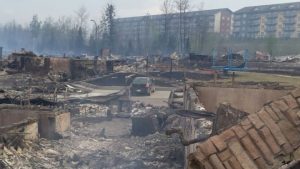Reinsurance is likely to shoulder at least 50% of the industry loss from the Fort McMurray area wildfire in Alberta, Canada, as uncertainty surrounding the overall loss estimate suggests a greater impact to reinsurers and also ILS players.
 Global ratings agency Standard & Poor’s (S&P) has reported that it expects the recent, devastating wildfire event in Alberta, Canada, to be an earnings event for both primary insurers and reinsurance companies, as more than 1,600 homes and buildings were destroyed in the event.
Global ratings agency Standard & Poor’s (S&P) has reported that it expects the recent, devastating wildfire event in Alberta, Canada, to be an earnings event for both primary insurers and reinsurance companies, as more than 1,600 homes and buildings were destroyed in the event.
“The losses from this event will hit the reinsurers and the proportion of the losses attributed to them could be up to half the losses at the lower end of the range, but the proportion of ceded losses will increase if loss estimates rise,” said S&P.
Due to the size of the event and the extent of the damage caused, significant uncertainty remains as to how high the re/insurance industry loss could be, with many reports predicting the wildfire to be the largest single event in Canada’s history.
S&P predicts that at the lower end of the range reinsurers will take up to 50% of the loss, and, given the uncertainty and complexity of the event, it wouldn’t be too surprising to see this go beyond the 50% mark as the total loss estimate could rise quite easily.
Artemis discussed recently that industry analysts had suggested that reinsurance and retrocession capacity could take as much as 70% of the loss from the event, due to insurers typically retaining low percentages of gross losses, and Canadian insurers’ reported heavy reliance on reinsurance and quota share.
And now analysts at S&P have also stressed that reinsurers will likely shoulder a significant volume of the losses, which, implies that a share of this will have an impact on insurance-linked securities (ILS) capital as well.
“We believe that the fire is likely an earnings event for both the primary companies and the reinsurers, which generally are more diversified globally and benefit from strong capitalization,” said S&P.
One of the ways insurers and reinsurers diversify and strengthen their capital base is with the use of ILS structures, such as collateralized reinsurance, sidecar ventures, and other third-party investor-backed mechanisms.
So with such a large portion of the wildfire loss expected to be borne by reinsurers, it’s very possible that some of this will hit the ILS players that participate in the region as well.
Furthermore, should the loss estimate continue to rise, which, as highlighted by S&P would result in an even greater share of the losses being passed on to reinsurers, it would likely mean a greater share of retrocession capacity is impacted, an area ILS funds and managers are prominent.
Potentially, then, the more reinsurance and retrocession capacity that shoulders the loss, the more ILS capacity is likely to take a share of the event loss as well, underlining just how large of an event the wildfire has been for the global re/insurance industry.
Further supporting the potential for ILS capacity to play a role here, S&P expects the majority of the losses will be borne by insurers in the property space, which is where most of the ILS capital is currently being put to work.
In light of this, and stressed by Artemis previously, it’s worth noting that due to the small size of the ILS market when compared to the overall reinsurance marketplace it’s likely ILS will only take a small portion of the losses, when compared with reinsurance.
“The event, in our opinion, would likely continue to reinforce the trend of rate increases, particularly for insured risks in Alberta more than other provinces. However, we are unlikely to see any impact on the pricing within the global reinsurance sector, which is currently facing soft market conditions,” said S&P.
Rates have been declining in the global reinsurance landscape for some time now, with a lack of large losses being one of the drivers of the softening landscape. But as noted by S&P, the Canada wildfire event alone, despite potentially being the largest event in the country’s history, is unlikely to be enough to have any significant impact on rates.
With authorities still working to control and assess the damage caused by the wildfire, it’s likely the loss estimate will continue to rise in the coming weeks, meaning that reinsurance and also ILS capacity could see its proportion of the loss increase. Although, by how much exactly, remains hard to tell.
Also read:
– Reinsurance & retro to take significant share of Canada wildfire loss.
– Japan quakes, Canada wildfire to take nat cats over budget in Q2: JPM.
– Fort McMurray wildfire a “reinsurance event”, maybe ILS: Deutsche Bank.
– Fort McMurray wildfire could cost insurers up to C$9bn: BMO Capital Markets.
 View all of our Artemis Live video interviews and subscribe to our podcast.
View all of our Artemis Live video interviews and subscribe to our podcast.
All of our Artemis Live insurance-linked securities (ILS), catastrophe bonds and reinsurance video content and video interviews can be accessed online.
Our Artemis Live podcast can be subscribed to using the typical podcast services providers, including Apple, Google, Spotify and more.































